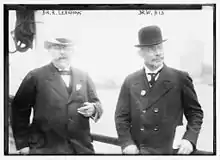Rudolph Lennhoff
Rudolph Lennhoff (14 July 1866, Lüdenscheid - December 25, 1933, Berlin)[1] was one of the best known medical authorities in Berlin.[2]

Biography
Following an investigation into the conditions of working class people with tuberculosis, undertaken jointly with Wolf Becher, Lennhof devised the open air cure that became the standard treatment for the disease for many decades. [3]
He also discovered what became known as ‘Lennhof’s sign’ - a furrow that appears between the liver and the bottom rib when the patient breathes in - indicating the presence of an ecchinoccus cyst.
In 1912 he attended the 15th International Congress on Hygiene and Demography, which opened 23 September 1912, in Washington, D.C..[4]
A liberal in his political views, Lennhof contributed to the liberal daily Vossische Zeitung and was a member of the Freisinniger Volkspartei. He was also one of the organisers, in 1905, of the Society for Social Medicine. [5]
References
- "Jüdische Schriftstellerrinnen und Schriftsteller in Westfalen". Universität Paderborn. Retrieved 26 October 2019.
- "Prof. Rudolph Lennhoff". New York Times. December 27, 1933. Retrieved 2009-02-22.
Prof. Rudolf Lennhoff, one of the best known medical authorities in Berlin, died last night of apoplexy at the age of 68. He was the publisher of a library for social hygiene and of medical statistics and was recognized as an authority in the fields of heart, stomach and kidney.
- Marta Gutman; Ning De Coninck-Smith (2008). Designing Modern Childhoods: History, Space, and the Material Culture of Children. Rutgers University Press. p. 108. ISBN 978-0-8135-4195-2.
- "200 Delegates to International Congress of Hygiene Keep Room Clerks Guessing". New York Times. 1912-09-18. Retrieved 2009-02-22.
Within an hour or so after the Cincinnati docked in Hoboken yesterday morning the lobby of the Plaza began to fill with men who looked very foreign and very learned. Most of them brought whiskers with them. The cool air that blow in from Central Park was much tempered by the time it reached the telephone booth, because many had got into the wrong hotel, or couldn't get their rooms at once. ... Dr. Rudolph Lennhoff said that among the most interesting subjects that would come up before this congress would be that of how to guard against ...
- Paul Weindling (1993-07-22). Health, Race and German Politics Between National Unification and Nazism, 1870-1945. Cambridge University Press. pp. 218–219. ISBN 978-0-521-42397-7.